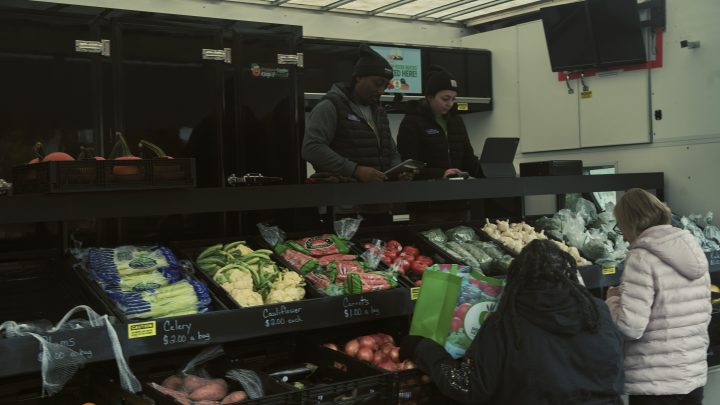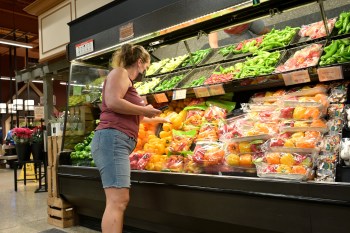
On Buffalo’s east side, inflation intensifies the daily struggle to buy food
On Buffalo’s east side, inflation intensifies the daily struggle to buy food

“Marketplace” host Kai Ryssdal and Nela Richardson, the chief economist of payroll-processing company ADP, recently spent several days in Buffalo, New York, for a series of conversations about how people experience inflation in their daily lives.
Like many cities in America, Buffalo is a place where wages for the lowest-paid workers have increased significantly in recent years — more than 40%, according to an ADP analysis — but costs are rising too.
Nationally, the cost of food at home — opposed to food purchased at restaurants — rose 13% over the past 12 months, according to the latest consumer price index. It’s one of the most persistently high categories of inflation right now.
So, on a rainy October morning, Ryssdal and Richardson watched a purple truck pull into a parking lot outside a supportive housing complex called Westminster Commons.

“Wow, look at that!” Ryssdal said as a worker opened the side of the truck to display baskets of fresh produce with handwritten prices.
“This is our Farm Market truck, where we sell produce — fruits and veggies — to local communities all around the city,” the truck’s driver, who goes by “H,” told Ryssdal and Richardson.
“And this stuff is not expensive,” Ryssdal noted to H. “Pears 50 cents apiece, grapes 3 bucks a box, nice bag of apples for $2. That’s pretty good.”

The truck is owned by FeedMore WNY, which operates a range of food access programs throughout the region. It’s aimed at bringing affordable, locally sourced produce to people who might otherwise lack access to fresh food.
East Buffalo, where Richardson and Ryssdal met FeedMore WNY’s Farm Market truck, is home to around 80% of the city’s Black residents. It’s dotted with more than 7,000 vacant lots, according to a 2021 report from the University at Buffalo Center for Urban Studies.
The Tops Friendly Markets on Jefferson Avenue, where a gunman killed 10 people and injured three others on May 14, opened in 2003 after a community-led campaign to bring a major supermarket to the area.
Outside Westminster Commons, Ryssdal and Richardson spoke with a Farm Market shopper named Carl, who said he typically takes two buses to reach his preferred grocery store. The trip takes 40 minutes each way. But when the Farm Market truck is there — every Wednesday morning — he can walk right outside his apartment to buy produce. “It’s very convenient,” he said.
Customers at the Farm Market truck can shop with credit or debit cards, SNAP government food benefits or special coupons provided by FeedMore WNY when they’re available.

“Originally, this was set up to service individuals that reside at our group homes and our affordable housing complexes and things of that nature,” said Chandra Redfern, CEO of the Buffalo Federation of Neighborhood Centers, which worked with FeedMore WNY to bring the Farm Market to this area. “We also know that everybody in the community should be accessing fresh fruits and vegetables … so this brings a more affordable option to them in their neighborhood.”
Another shopper, who declined to give her name but told Ryssdal and Richardson that she lives entirely on Social Security benefits and other government assistance, said she typically shops for groceries just once a month.
“Why once a month?” Ryssdal asked. “Because that’s when I get my food stamps,” she said. “I buy three or four loaves of bread [and] put them in the freezer.”
Fixed-income shoppers like her tend to spend a higher portion of their monthly budgets on groceries than people who earn higher wages. Because the cost of food is rising faster than other prices, they’re among the hardest hit by inflation.
“It means that I have to get less food,” the shopper told Ryssdal when he asked what rising prices meant for her. “I plan very carefully with my food stamps so I can have the things I like to eat.”
Click the audio player above to hear Ryssdal and Richardson’s conversations at the Farm Market truck
There’s a lot happening in the world. Through it all, Marketplace is here for you.
You rely on Marketplace to break down the world’s events and tell you how it affects you in a fact-based, approachable way. We rely on your financial support to keep making that possible.
Your donation today powers the independent journalism that you rely on. For just $5/month, you can help sustain Marketplace so we can keep reporting on the things that matter to you.

















